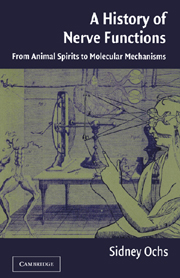Book contents
- Frontmatter
- Contents
- Preface
- 1 Introduction: Greek Science and the Recognition of Nerve as a Channel
- 2 Galen's Physiology of the Nervous System
- 3 Nerve, Brain, and Soul in the Middle Ages
- 4 Renaissance and the New Physiology
- 5 New Physical and Chemical Models of Nerve in the Enlightenment
- 6 New Systematizations of Nerve Function in the Enlightenment
- 7 Electricity as the Agent of Nerve Action
- 8 Nerve Fiber Form and Transformation
- 9 Wallerian Degeneration: Early and Late Phases
- 10 Nerve Regeneration
- 11 Characterization of Axoplasmic Transport
- 12 Molecular Models of Transport
- 13 Actions of Neurotoxins and Neuropathic Changes Related to Transport
- 14 Purposeful Reflexes and Instinctive Behavior
- 15 Neural Events Related to Learning and Memory
- 16 Epilogue: With Observations on the Relation of the Nervous System to Mind
- Bibliography
- Index
7 - Electricity as the Agent of Nerve Action
Published online by Cambridge University Press: 13 August 2009
- Frontmatter
- Contents
- Preface
- 1 Introduction: Greek Science and the Recognition of Nerve as a Channel
- 2 Galen's Physiology of the Nervous System
- 3 Nerve, Brain, and Soul in the Middle Ages
- 4 Renaissance and the New Physiology
- 5 New Physical and Chemical Models of Nerve in the Enlightenment
- 6 New Systematizations of Nerve Function in the Enlightenment
- 7 Electricity as the Agent of Nerve Action
- 8 Nerve Fiber Form and Transformation
- 9 Wallerian Degeneration: Early and Late Phases
- 10 Nerve Regeneration
- 11 Characterization of Axoplasmic Transport
- 12 Molecular Models of Transport
- 13 Actions of Neurotoxins and Neuropathic Changes Related to Transport
- 14 Purposeful Reflexes and Instinctive Behavior
- 15 Neural Events Related to Learning and Memory
- 16 Epilogue: With Observations on the Relation of the Nervous System to Mind
- Bibliography
- Index
Summary
In the preceding chapters, various agents of nerve action were put forward to account for the rapidity with which nerves conduct sensations and produce motor responses as occurs in a reflex such as that in the example given by Descartes (Chapter 5), where a foot is burned and rapidly withdrawn even before the pain is sensed. The various new physical principles and chemical entities discovered in the Renaissance were advanced to serve this function, but failed to fit all the properties of nerve action. Electricity had properties that suggested that it might be the long sought-for agent of nerve action. It was invisible and imponderable; acting with lightning speed and having profound excitatory actions on the nerves and muscles. How electricity came to be accepted as the agent of nerve conduction is the theme of this chapter. Its history can be divided into three periods. The first period extended from ancient times to that of Galvani at the turn of the eighteenth century when electricity was generated as a static discharge and its potent effects on the body experienced. The second period extends from the introduction of the battery by Volta after the turn of the nineteenth century, when the flow of current in body tissues was investigated, though not differentiated from electrical conduction in metals.
- Type
- Chapter
- Information
- A History of Nerve FunctionsFrom Animal Spirits to Molecular Mechanisms, pp. 108 - 129Publisher: Cambridge University PressPrint publication year: 2004



